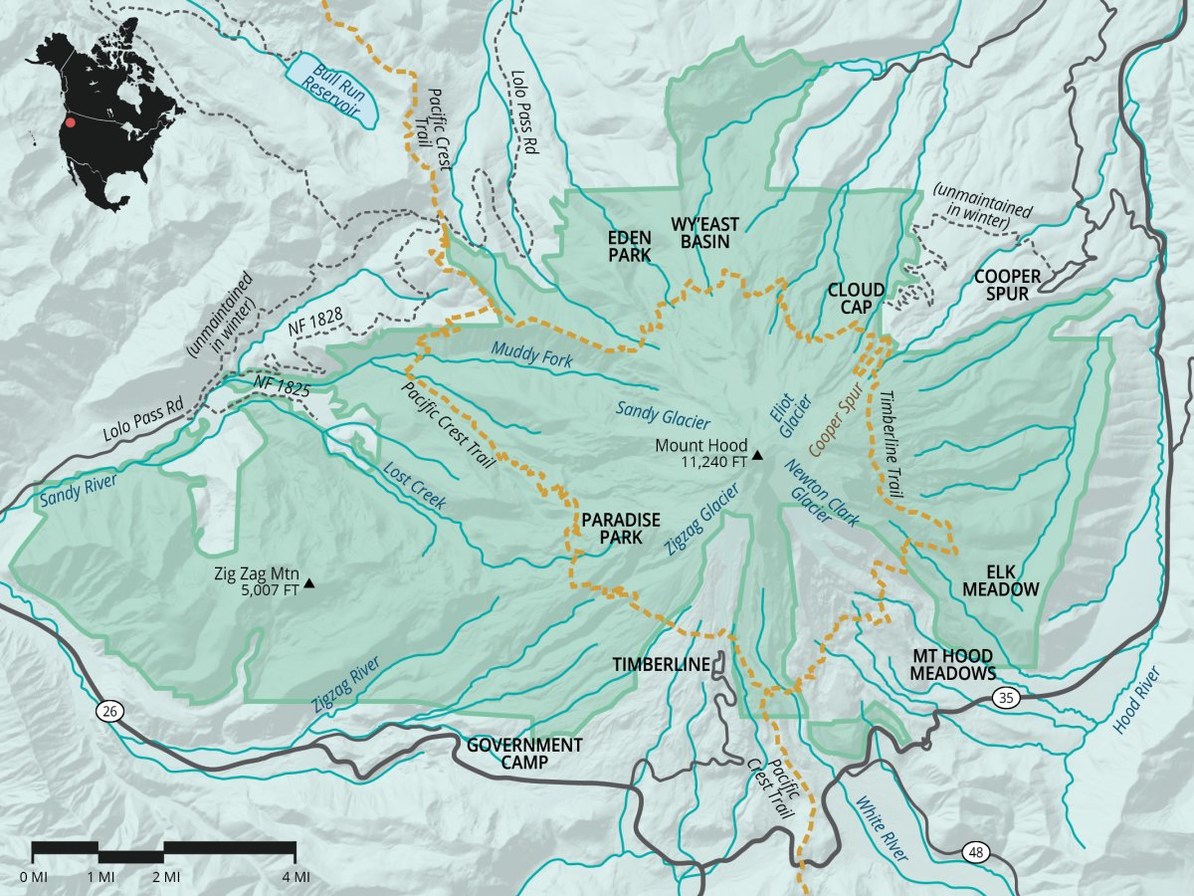You are here

Mount Hood is the tallest mountain in Oregon, and also its most well known. From Portland, as long as it isn't raining, the mountain is visible, standing 11,250 feet above the city's skyline. Much of the area encompassing the mountain was designated as wilderness with the 1964 passage of the Wilderness Act. Today, the wilderness area covers over 63,000 acres. Other than the downhill ski resorts on Mount Hood's southern exposure, most of the mountain falls within the Mount Hood Wilderness.
The wilderness status was a critical step to protect a special high alpine ecosystem. Lower elevations are primarily a forest of Douglas fir, interspersed with Oregon grape, salal, rhododendron, and late summer huckleberries. Wildlife, such as pikas, marmots, black bears, deer and elk, also live up to the tree line.
During the Great Depression, the Works Progress Administration commissioned a number of projects on Mount Hood. Government Camp, the base camp for these projects, retains the functional name of what the town was used for. Timberline Lodge, the most impressive of the projects, sits at 5,960 feet on the mountain's southern slopes. It serves as the ski lodge for Timberline Resort and as a the starting point for a number of hiking trails. It's also where the south route via the Old Chute to Mount Hood's summit starts, what is by far the most popular way to the top. Mount Hood is the most climbed glaciated peak in North America, and globally only second to Mount Fuji in Japan. Tilly Jane A-Frame, on the north side of the mountain, was also built in the 1930s. Nearby Cloud Cap Inn was built even earlier, in the 1880s.
Visiting the Wilderness Area
During the summer months, Mount Hood is a popular destination for hiking, camping and mountain climbing. Most hiking trails in the wilderness area include backcountry camping spots, generally more private than camping at the more popular lakes south of Mount Hood.
The western portions of the Mount Hood Wilderness are dominated by the runoff from the Sandy Glacier. Hiking along the Sandy River leads to the impressive Ramona Falls, one of Oregon's most iconic waterfalls. The trail to the falls doesn't offer much in the way of views of Mount Hood, but there are a number of hikes that do. McNeil Point goes by the McNeil Point Shelter, an old rock structure, and takes you up close to the Sandy Glacier. The Pacific Crest Trail also runs alongside the western slopes of Mount Hood at Paradise Park, which comes alive with wildflowers in the summer. Or, if you're looking for a wilderness adventure off the beaten track, explore the Muddy Fork. And if you want to circle Mount Hood, you can hike the nearly 40 mile Timberline Trail and backpack along the way.
In the winter, hiking and camping gives way to snowshoeing, cross country skiing, sledding and winter mountaineering. Downhill skiing is by far the most popular reason for visiting Mount Hood in the winter time, but the four resorts on the mountain are outside of the designated wilderness area. For wilderness snowshoeing routes, Cooper Spur via Tilly Jane is a great there-and-back route, as is Cloud Cap Road. White River West Sno-Park is a great option for sledding on the southern slopes of Mount Hood. Numerous other trails may or may not be accessible in the area for winter access depending on snowpack and the prevailing conditions.
Sandy Glacier Caves
In 2011, an ice cave network on Mount Hood's Sandy Glacier was explored and documented by Eddy Cartaya and Brent McGregor. Their findings confirmed that the network of three caves, named Snow Dragon, Pure Imagination and Frozen Minotaur, were the largest in the contiguous United States. The caves came to prominence in an in-depth report by Oregon Field Guide, which aired in 2013. Although the cave network is accessible by hikers in late summer, conditions are variable with fluctuating daily temperatures reaching well above freezing, and it's not uncommon for large boulders to drop from the caves' ceilings. It's best to visit the caves in the fall and winter months when temperatures stay below freezing. Mountaineering equipment, and mountaineering knowledge, are required for the crossing the glacier and reaching the caves.
Logistics + Planning
Current Weather: Powered by Dark Sky























Comments
Sign In and share them.